Transform your outdoor adventures into Earth-friendly experiences by choosing camping gear that minimizes environmental impact while maximizing durability. Master essential camping skills with equipment designed to leave no trace on Ontario’s pristine wilderness. From ultralight recycled polyester tents to solar-powered lighting solutions, today’s eco-conscious gear combines cutting-edge sustainability with rugged performance.
Gone are the days when “green” meant sacrificing quality or comfort. Modern sustainable camping equipment handles Ontario’s diverse conditions – from humid summers to crisp fall nights – while reducing your carbon footprint. Local outfitters now stock an impressive array of biodegradable camping supplies, responsibly sourced sleeping bags, and reusable water filtration systems that eliminate single-use plastic waste.
Whether you’re planning a weekend at Algonquin or a week-long trek through the Frontenac wilderness, choosing eco-friendly gear isn’t just about environmental responsibility – it’s about creating a deeper connection with nature while preserving it for future generations of outdoor enthusiasts.
Essential Sustainable Camping Equipment
Solar-Powered Solutions
In Ontario’s variable weather conditions, reliable solar-powered gear is a game-changer for eco-conscious campers. The latest portable solar panels are surprisingly efficient, even on cloudy days, making them perfect for our mixed weather patterns. I’ve found that foldable 21W panels work best for our latitude, providing enough juice to charge phones and small devices within 2-3 hours of decent sunlight.
For evening illumination, solar-powered string lights and lanterns are must-haves. Look for models with at least 8 hours of battery life and water-resistant ratings – trust me, you’ll appreciate this during those unexpected summer showers. The Goal Zero Crush Light has become a personal favorite, offering up to 35 hours of gentle illumination on a single charge.
Solar power banks are another essential. Opt for models with at least 10,000mAh capacity and multiple charging ports. The latest units feature quick-charging capabilities and weather-resistant construction. For best results, position your solar gear in open areas away from tree cover, and consider bringing a backup power bank for those rare extended cloudy periods we sometimes get in Ontario’s backcountry.
Remember, while these solutions require a higher upfront investment, they’ll save you money in the long run while reducing battery waste in our beautiful parks.
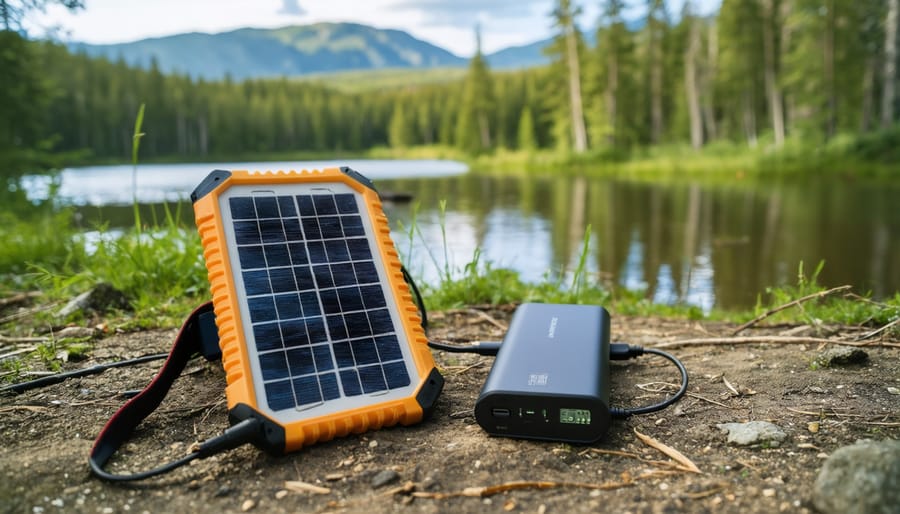
Sustainable Sleeping Systems
Rest easy knowing your sleeping setup can be both comfortable and eco-conscious. Modern seasonal camping equipment has come a long way, with many sustainable options perfect for Ontario’s varied climate. Look for tents made from recycled polyester or ripstop nylon, which often come from reclaimed plastic bottles. Companies like Big Agnes and Mountain Equipment Co-op offer tents with solution-dyed fabrics that use less water in production and last longer.
For sleeping bags, consider options filled with recycled synthetic materials or responsibly sourced down. Brands like Patagonia and ThermaRest now use post-consumer recycled materials in their insulation, providing warmth without environmental compromise. Their sleeping pads follow suit, utilizing recycled foam and eco-friendly manufacturing processes.
Pro tip: Many Ontario outfitters now rent sustainable sleeping gear, perfect for occasional campers who want to try before buying. This approach not only reduces waste but also helps you find the perfect fit for your camping style while supporting local businesses.
Remember to look for repair-friendly gear with available replacement parts – the most sustainable equipment is the kind that lasts for years of adventures.
Water Management Tools
When it comes to staying hydrated while camping, eco-conscious gear can make a world of difference. Filtered water bottles like the LifeStraw Go have become a game-changer for Ontario campers, letting you safely drink from lakes and streams while eliminating the need for single-use plastic bottles. I’ve found these particularly useful during longer portages when carrying extra water would be too heavy.
For group camping, consider investing in a gravity-fed water filtration system. These ingenious devices can filter several liters of water at once – perfect for base camp setups at spots like Algonquin Park. Simply fill the reservoir, hang it from a tree, and let gravity do the work while you set up camp.
Don’t forget to pack a few collapsible water containers for camp kitchen duty. These silicon-based containers fold down when empty, saving precious pack space. Pro tip: bring one dedicated container for collecting grey water from dishwashing, making it easier to dispose of properly at designated facilities.
For daily hydration on the trail, insulated stainless steel bottles keep your water cool even during hot summer hikes, and they’ll last for years with proper care.
Zero-Waste Cooking Equipment
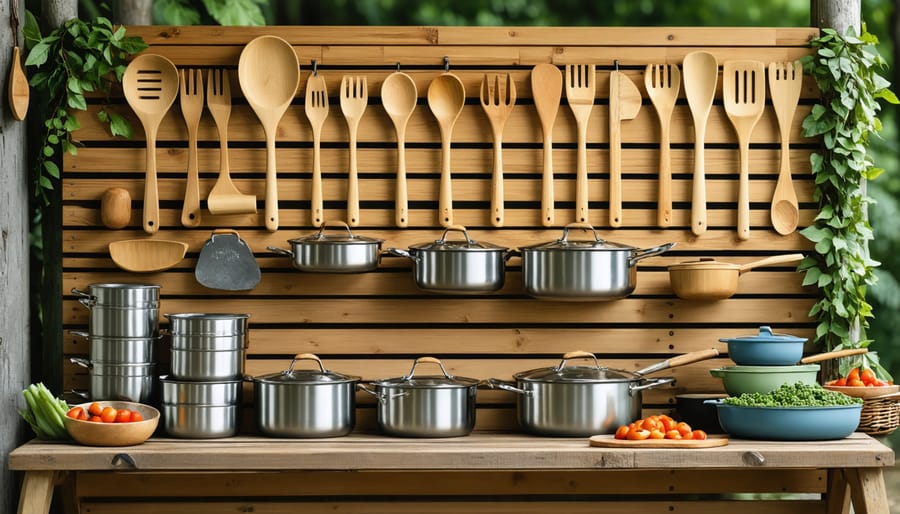
Reusable Cookware and Utensils
When it comes to eco-friendly camping cookware, durable and reusable options are your best friends in the great outdoors. Skip the disposable plates and plastic utensils, and invest in a reliable set of stainless steel or titanium camping cookware. I’ve found that a good quality mess kit with nesting pots and pans not only saves space but can last for decades of camping adventures.
For utensils, bamboo or stainless steel sets are fantastic alternatives to plastic. They’re lightweight, won’t leach chemicals into your food, and can handle the heat of cooking over a campfire. Pro tip: Look for sets that clip together or come with a carrying case to prevent losing pieces in your pack.
Consider picking up enamel plates and mugs – they’re virtually indestructible and add a touch of classic camping charm to your outdoor meals. For food storage, mason jars and stainless steel containers work brilliantly. They’re leakproof, don’t retain food odors, and keep curious wildlife from being attracted to your campsite.
A cast iron skillet might seem heavy, but it’s worth its weight in gold for camping. With proper care, it’ll last generations and actually improves with use. Plus, it’s perfect for everything from morning pancakes to evening campfire stews. Just remember to keep it properly seasoned and dry to prevent rusting.
Don’t forget a good quality water bottle and coffee percolator – these daily-use items should be built to last. Stainless steel or double-walled titanium options are excellent choices that’ll keep your beverages at the right temperature without any plastic waste.
Food Storage Solutions
When it comes to keeping your food fresh while camping, eco-friendly solutions are both planet-friendly and practical. Stainless steel containers are the gold standard for sustainable food storage – they’re virtually indestructible, don’t retain odors, and can last for decades. I’ve been using the same set for over five years, and they still look brand new!
Mason jars are another fantastic option that many Ontario campers swear by. They’re perfect for storing dry goods, preparing overnight oats, or keeping trail mix fresh. Plus, they’re readily available at local shops and can be reused countless times.
For longer trips, beeswax wraps are a game-changer. These natural alternatives to plastic wrap keep sandwiches fresh and can be washed and reused for months. Many Ontario artisans make beautiful custom wraps, often using local beeswax.
Consider investing in silicone storage bags for snacks and smaller items. They’re lightweight, waterproof, and can handle both hot and cold temperatures – perfect for Ontario’s variable weather. Unlike disposable plastic bags, they can be washed and reused hundreds of times.
Pro tip: Create a dedicated “bear-proof” food storage system using airtight stainless steel containers combined with a sturdy rope for hanging. This not only protects your food but also keeps local wildlife safe by reducing their exposure to human food and packaging.
Remember to label your containers with biodegradable tape or markers to stay organized throughout your trip. This simple step helps reduce food waste and makes meal planning a breeze.
Local Eco-Friendly Gear Shops
Looking to support local businesses while gearing up for your eco-friendly camping adventure? Ontario is home to several outstanding retailers that specialize in sustainable outdoor equipment. Here are some of our favorite spots where you can find earth-conscious camping gear:
MEC (Mountain Equipment Co-op) leads the charge with locations in Toronto, Burlington, and London. Their gear recycling program and commitment to sustainable manufacturing make them a go-to destination. They offer everything from recycled polyester tents to solar-powered camping lights, and their knowledgeable staff can help you make environmentally conscious choices.
For Toronto-based campers, Wilderness Supply Company in Kensington Market is a hidden gem. This family-owned shop focuses on durable, sustainable gear and offers repair services to extend the life of your equipment. They’re known for their carefully curated selection of locally made camping gear and zero-waste camping accessories.
In Ottawa, Trailhead Paddleshack stands out for its collection of eco-friendly camping equipment. They specialize in biodegradable camping soaps, solar chargers, and recycled material sleeping bags. The store also hosts monthly workshops on sustainable camping practices and gear maintenance.
The Guelph Outdoor Store deserves special mention for its dedication to sustainable brands. Their camping section features products made from renewable materials and they offer a trade-in program for gently used gear.
Local tip: Many of these stores have seasonal sales in early spring and late fall, perfect for stocking up on sustainable gear at better prices. Some also offer rental services, which is an excellent way to try out equipment before making a purchase or for occasional campers looking to minimize consumption.
Remember to ask about each store’s repair services – fixing gear instead of replacing it is one of the most environmentally friendly choices you can make. Most of these shops also host community events and workshops focused on sustainable outdoor practices, so be sure to check their event calendars.
Care and Maintenance Tips
Cleaning and Storage
Keeping your eco-friendly camping gear in top condition doesn’t mean resorting to harsh chemicals. Instead, use natural cleaning solutions like vinegar and water for tents and tarps, and baking soda paste for stubborn stains. A simple mix of lemon juice and salt works wonders on metal surfaces, while coconut oil can effectively clean and protect leather items.
After each camping trip, thoroughly air-dry all equipment before storage – moisture is the enemy of longevity! Set up your tent in a shaded outdoor area or well-ventilated garage for a few hours. For sleeping bags, hang them upside down and give them a gentle shake to restore loft. Pro tip: skip the dryer sheets and use a cup of white vinegar in your washing machine to eliminate odors naturally.
Store your gear in a cool, dry place away from direct sunlight. Instead of plastic bins, opt for breathable cotton storage bags or repurposed cardboard boxes. Keep sleeping bags uncompressed in large cotton sacks – this preserves their insulating properties. For tents, avoid folding along the same lines each time to prevent permanent creases and fabric weakness.
Consider creating a gear maintenance calendar – monthly checks can catch small issues before they become big problems. Quick repairs using eco-friendly patches and natural waterproofing solutions will extend your gear’s life significantly. Remember, well-maintained equipment not only lasts longer but also performs better, making your camping adventures more enjoyable while reducing waste.
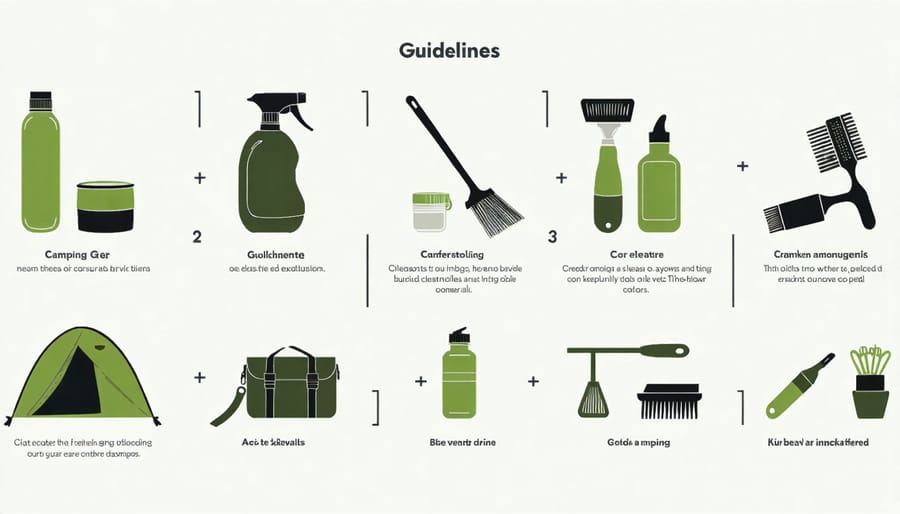
Repairs and End-of-Life Solutions
Don’t let a small tear or broken zipper send your camping gear to the landfill! Most common issues can be fixed with some basic DIY skills and the right tools. Keep a repair kit handy with items like seam sealer, fabric patches, and a needle and thread. For tents, a patch kit can fix small holes, while waterproof tape works wonders for rainfly repairs. Sleeping bags with broken zippers can often be fixed with a zipper repair kit or taken to a local repair shop.
Many outdoor retailers in Ontario, like MEC and SAIL, offer repair services for their products. Some even host repair workshops where you can learn to fix your gear while connecting with fellow outdoor enthusiasts. For more complex repairs, check out Toronto’s growing network of repair cafes, where volunteer experts help fix everything from camping stoves to backpacks.
When gear truly reaches the end of its life, consider these eco-friendly disposal options. Many outdoor retailers run take-back programs – MEC accepts old hiking boots and climbing ropes for recycling. Local outdoor education programs and Scout groups often welcome donated gear that’s still usable but no longer meets your needs. For synthetic materials, check with TerraCycle’s specialized recycling programs.
Remember, the most sustainable gear is the gear you already own. Regular maintenance, like cleaning your tent after trips and properly storing sleeping bags, can significantly extend the life of your equipment and reduce waste.
As we wrap up our journey through eco-friendly camping gear, remember that sustainable camping isn’t just about the equipment you bring – it’s about fostering a deeper connection with nature while protecting it for future generations. By choosing durable, environmentally conscious gear, you’re not only reducing your carbon footprint but also enhancing your outdoor experience in Ontario’s beautiful wilderness.
From solar-powered lanterns to biodegradable camping supplies, every sustainable choice makes a difference. Consider starting small by replacing one or two items in your camping kit with eco-friendly alternatives. As your gear naturally wears out, continue making mindful upgrades to build your ultimate sustainable camping collection.
Don’t forget the basics: repair and maintain your equipment regularly, borrow or rent gear for occasional use, and support local Ontario businesses that prioritize environmental responsibility. Share your sustainable camping knowledge with fellow outdoor enthusiasts, and lead by example when enjoying our provincial parks.
Remember, the most eco-friendly gear is often the stuff you already own and maintain well. By embracing these sustainable practices and choosing environmentally conscious equipment, you’re helping preserve Ontario’s natural spaces for countless adventures to come. Happy sustainable camping, and see you on the trails!









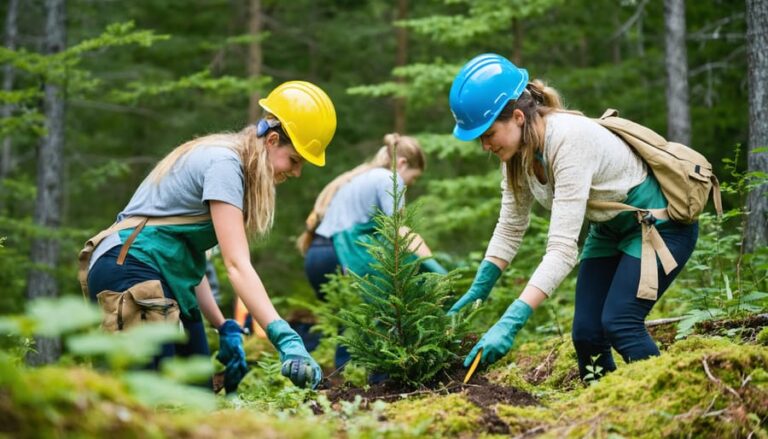

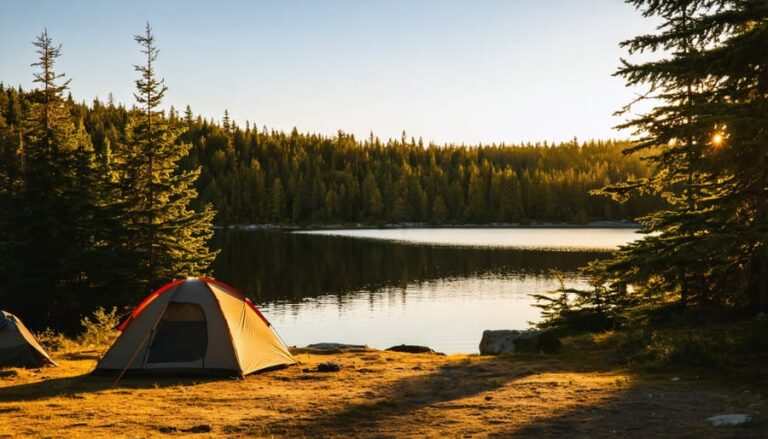


+ There are no comments
Add yours